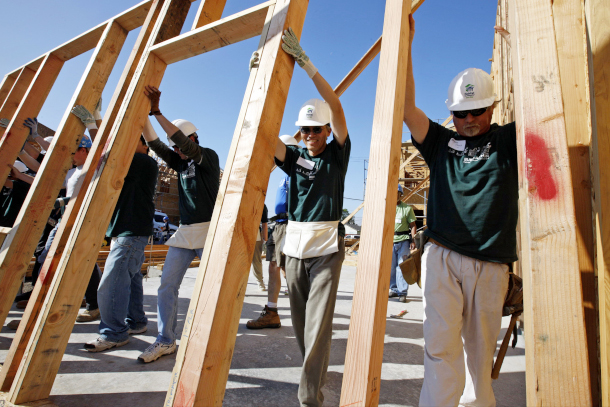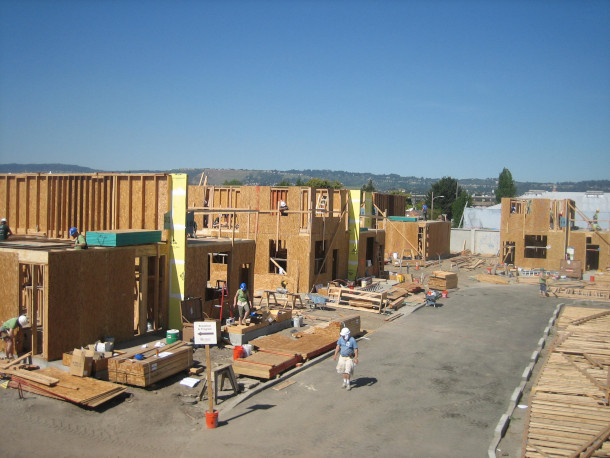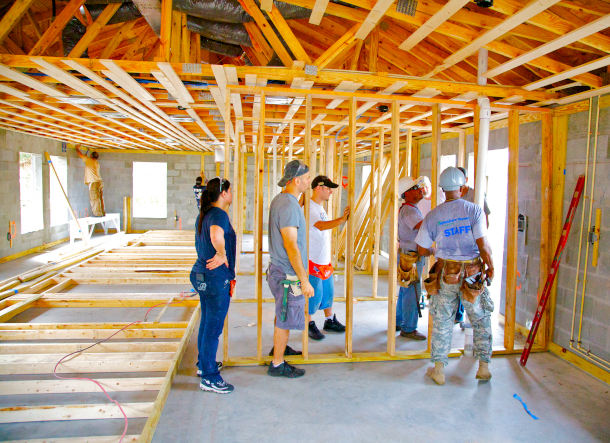Can the Planet Afford Gas in New Homes?
Air Date: Week of September 6, 2024

Volunteers raise a wall into place during the Habitat for Humanity Earth Day 2009 in Oakland, California. (Photo: Sandia National Laboratories, Flickr, CC BY-NC-SA 2.0).
Some new affordable homes built by Habitat for Humanity are being fitted with solar panels and labeled as “zero-net energy”, meaning they are supposed to produce as much or more energy than they use. But as reporter Dharna Noor of the Guardian explains to Host Jenni Doering, some of these homes include gas appliances, canceling out many of the climate benefits.
Transcript
DOERING: Rooftop solar, weatherization and efficient appliances can lower the overall carbon footprint of homes and even make them “zero-net energy”, meaning they produce as much or more energy than they use. And local affiliates of the nonprofit Habitat for Humanity are building such homes intended to give people affordable housing while also helping the planet. But appliances powered by fossil fuels are being installed in some of these homes, canceling out many of the climate benefits and potentially harming the health of the people living there. Dharna Noor reported on this for the Guardian and joins me now. Welcome to Living on Earth!
NOOR: Thanks so much for having me. It's exciting to be here.
DOERING: What are zero net energy homes, and how do the homes featured in your investigation claim to qualify?
NOOR: Yeah, it's interesting. So, zero net energy homes are essentially supposed to be homes that create more power than they use. So, in this case, they're homes that are outfitted with solar panels on their roofs. They're meticulously sort of weatherized and insulated to ensure that no unnecessary energy is being used to boost efficiency. But the actual appliances in the homes can be powered by anything in Zero Net Energy Homes, and in the story that I wrote about the case of utilities partnering with Habitat for Humanity chapters, it's actually gas that is powering many of these appliances, such as stoves and furnaces and water heaters.
DOERING: So how realistic is the expectation that these homes can actually achieve zero net energy use when gas is being used in these homes?
NOOR: So yeah, it's a great question, and there's sort of two issues here. One of them is that, as you're sort of suggesting, there is some evidence that in at least one case, one of these so-called dual fuel homes, that's a home that runs on gas for appliances but also is outfitted with solar panels, was not meeting that benchmark, but a fully electric one in the same sort of region was. That said there are certainly homes that have gas appliances in them that are meeting the zero net energy benchmark. But the bigger issue here is that even if they are producing more energy than they're using, they're still producing emissions, greenhouse gas emissions, planet warm and pollution. So simply producing power from solar panels on your rooftop does not actually cancel out the emissions from, say, your furnace or your stove if they run on gas. And there's another thing at play here too, which is that placing gas in homes is not only itself a source of emissions, but it actually sort of gives an excuse to continue producing gas. You know, pulling it out of the ground, extracting it, sending it through pipelines, distributing it to homes and homes that purport to be zero net energy, even if they do meet that benchmark, if they run with gas in them, they can sort of give city officials a message that, hey, we actually need to keep producing this planet heating fossil fuel to ensure that, you know, people have access to cooking appliances and warm air and warm water and things like this. So, while some of them actually do meet the benchmark there are some issues at play, I guess I'd say.

The “zero-net energy homes” built by Habitat for Humanity affiliates are meant to produce as much or more energy than they use, but the homes also come with gas appliances, canceling out many of the homes’ climate and energy benefits. Pictured above is a home from Habitat for Humanity’s Build-A-Thon site in Oakland, California. (Photo by Sandia National Laboratories. Flickr, CC BY-NC-SA 2.0)
DOERING: So, proponents of gas will say it is cleaner burning than, for example, like an oil powered furnace, which I used to have in an apartment. But what are the concerns when it comes to the emissions that can be produced from gas in homes?
NOOR: Yeah, the question of how clean gas is relative to other fossil fuels sort of depends who you ask, I guess. Industry interests have long claimed that gas is cleaner than oil and coal, you know, the other sort of main fossil fuels that we use. There's some evidence for that, but then there's other evidence that actually shows that if you take the methane emissions into account, it's actually more planet warming than coal from sort of extraction to use. So natural gas, as it's called by industry interests, is actually mostly made of methane, and that's a planet heating gas that is actually 80 times more planet warming than carbon dioxide in the short term. So, it's a pretty huge sort of contributor to fossil fuel use and to greenhouse gas emissions. So again, sort of depends what you ask how clean it is, but I think there's plenty of evidence that shows that industry interests have certainly been calling it a clean fuel, when, in fact, experts are very, very concerned about not only its effects on the climate, but also its effects on human health.
DOERING: So, explain, please, why some climate advocates are saying that this practice of putting gas into these so called Zero Net Energy Homes that this is a big public relations stunt. What's going on there?
NOOR: Yeah, I mean, it's something where I think the concerns of some of these climate advocates really bore out in my research. So, I talked to a guy named Itai Vardi. He works at the sort of watchdog group called Energy and Policy Institute that's really pro-electrification. And he basically said that the project of installing these so called zero-net-energy homes with Habitat for Humanity chapters by gas utilities, he said this project is a cynical PR stunt. And in fact, that seems like it was not just a sort of vibes-based analysis, I actually was able to obtain industry webinar recordings and other sort of internal documents that showed that that is basically the case. You know, during this one webinar that I watched from last year, there was a representative from the utility Atmos Energy that's created these zero-net-energy homes with Habitat chapters all over the US, and they said that these projects actually began as a response to the attempts to get gas out of buildings. So the first one of these projects was in Colorado, and he said, and this is a direct quote: "In Colorado, they are a little bit on the front lines, as far as some of efforts to maybe dissuade people from utilizing natural gas, and as such, that became the chosen site for our very first natural gas ZNE, that's a zero-net-energy home build". So essentially, what he's saying here is, hey, in Colorado, they're actually like getting some support to try to get gas out of homes. And so, we put this here intentionally to try to combat those efforts.
DOERING: By the way, Darna, where are these homes being built?
NOOR: So, these homes are in a lot of different places. Atmos Energy, which is a gas utility, launched the project again in Colorado in September 2021, and it since expanded it to a bunch of different places, Kentucky, Louisiana, Texas, Mississippi, Tennessee. And it also has new plans now to launch similar initiatives in Virginia and Kansas. And then there's a couple other utilities that have used a sort of similar model. There's national fuel that operates in the Northeast and then there's SoCalGas, which operates, of course, in Southern California. Nicor, which is another gas utility that operates specifically in Illinois, has also partnered with Habitat on zero net energy projects. So really, these are pretty pervasive in lots of different parts of the country.

Most Habitat for Humanity “net-zero energy homes” cater to low-income members of vulnerable communities, including people of color and veterans. Pictured above is the inside of a Habitat for Humanity house in Miami, Florida. (Photo: Blitz Build, Flickr, CC BY-NC-ND 2.0)
DOERING: Now Darna, there are studies that we've reported on Living on Earth that link gas stoves to poor indoor air quality and problems like asthma.
O'NEILL: Yes.
DOERING: To what extent do you think that those health impacts might be especially harmful for the low income and minority communities that this affordable housing is being built for?
NOOR: Yeah, this is such a good question, and it's something that really sort of concerned me when I learned about these projects. Experts have been warning for a really long time that gas appliances emit lots of toxic pollutants, including carcinogens. And as you're sort of saying, a recent slew of studies has linked gas stoves to specifically increased risk of childhood asthma, as well, as you know, things like chronic lung disease and a bunch of other health impacts. And you're right in sort of wondering about the specific effects on low-income people. There's plenty of research that shows that low-income people and people of color specifically may be at higher risk if they're exposed to these sort of toxins in their homes, because they might be more likely to have asthma and underlying respiratory issues already due to the sort of disproportionate exposure to environmental contaminants that we see in this country based on a very racist history of things like redlining and the way that highways have been built and things like this. So, it's a way that I think this project, sort of, you might say, adds insult to injury. Not only is it low-income people who are being used as the sort of excuse to place more gas in homes, but they themselves, via these projects, may also be getting exposed to harmful pollutants that could really harm their health and their children's health.
DOERING: Dharna, I understand there are some fully electric homes that Habitat for Humanity is building.

Dharna Noor reports on fossil fuels and climate for The Guardian US. (Photo: Courtesy of Dharna Noor)
NOOR: There are.
DOERING: So, to what extent could those serve as a model for future projects?
NOOR: Yeah, this is part of what's so interesting about the sort of Habitat model here. I spoke with Habitat International, and they said that they're certainly concerned about climate change. They purport to be a sort of climate leader, but they also said that they sort of leave it up to individual habitat chapters to decide what kinds of projects they're going to embark on and how they get their funding. But Habitat for Humanity’s affiliate in Cape Cod, Massachusetts, actually did build all electric homes in partnership with a public utility in Cape Cod. In 2021 it was actually rated the best rated habitat home in the nation in terms of efficiency. Another habitat affiliate in Massachusetts actually built another all electric, zero net energy home that won praise from the federal government. They did not partner with utility. And actually this year, the federal government announced $2 billion for a coalition of nonprofits, including Habitat for Humanity International and some sort of climate focused nonprofits. So, in essence, while there are habitat chapters that are partnering with gas utilities to put more gas into low income homes, Habitat International is actually embarking on this project to spend lots of money to build fully electric low-income housing. So certainly, I think that that provides a lot more evidence that we don't really need to put polluting fuels like gas in homes in order to ensure that people can afford them.
DOERING: So, looking at the big picture here, how important is safe and affordable climate-controlled housing in a world where extreme heat is creating dangerous conditions in cities?
NOOR: Yeah, I mean affordable housing is absolutely, of like, complete paramount importance, especially at a time when the climate crisis is getting so much worse. We see, for instance, that low-income homes are often more likely to be built in flood plains, the heat island effect, which means that places that have a lot of asphalt and paved areas kind of soak in more heat. That effect can mean that low-income people are much, much more exposed to dangerous temperatures, and also affordable housing can often be the housing that is kind of not kept up with very well. It can often be left to deteriorate, and that means that it's often much less efficient than housing that you know, sort of wealthier people are able to live in. So, it's really, really important to have affordable housing and also climate safe housing, and obviously, I applaud efforts to get people into safe, affordable homes. Again, though, just would venture to say that there's no reason to pit the interests of people in having affordable homes against the interests of people in having a livable climate, especially when there's tons and tons and tons of research, just mounds of research that show that low-income people in the US and elsewhere are more vulnerable to the effects of the climate crisis.
DOERING: Dharna Noor is the Fossil Fuels and Climate reporter for The Guardian US. Thank you so much for joining us today.
NOOR: Thanks for having me.
DOERING: Just a note on the comparison of methane versus carbon dioxide when it comes to how much they warm the planet. When methane is burned in a gas stove or furnace, most of it is converted to carbon dioxide, so it counts the same as any other molecule of CO2. Still, some of it does leak into the atmosphere between when it’s extracted and when it makes it to your stove, and that’s where the 80 times potency difference comes into effect.
Finally, when asked about its policy on gas in homes, Habitat for Humanity International provided a statement that reads in part: “Habitat International and our diverse network of Habitat affiliates and organizations – each an independent local non-profit – rely on a wide range of partners and home energy sources to help increase access to safe, decent, and affordable shelter. Some of those partnerships, including those cited in the Guardian article, seek climate-change solutions related to housing, and Habitat organizations continue to evaluate which ones are most effective.” You can read the full statement on the Living on Earth website, loe.org.
Statement from Habitat for Humanity International
“Habitat for Humanity’s vision is of a world where everyone has a decent place to live, but we cannot reach that vision alone. In the midst of a historic housing crisis in the United States and around the world, Habitat International and our diverse network of Habitat affiliates and organizations – each an independent local non-profit -- rely on a wide range of partners and home energy sources to help increase access to safe, decent, and affordable shelter. Some of those partnerships, including those cited in the Guardian article, seek climate-change solutions related to housing, and Habitat organizations continue to evaluate which ones are most effective. Whether through these partnerships in the U.S. or through our advocacy on housing and climate change globally, Habitat is confronting a complex and growing housing crisis so that more people have a decent place to call home.”
Links
Living on Earth wants to hear from you!
Living on Earth
62 Calef Highway, Suite 212
Lee, NH 03861
Telephone: 617-287-4121
E-mail: comments@loe.org
Newsletter [Click here]
Donate to Living on Earth!
Living on Earth is an independent media program and relies entirely on contributions from listeners and institutions supporting public service. Please donate now to preserve an independent environmental voice.
NewsletterLiving on Earth offers a weekly delivery of the show's rundown to your mailbox. Sign up for our newsletter today!
 Sailors For The Sea: Be the change you want to sea.
Sailors For The Sea: Be the change you want to sea.
 The Grantham Foundation for the Protection of the Environment: Committed to protecting and improving the health of the global environment.
The Grantham Foundation for the Protection of the Environment: Committed to protecting and improving the health of the global environment.
 Contribute to Living on Earth and receive, as our gift to you, an archival print of one of Mark Seth Lender's extraordinary wildlife photographs. Follow the link to see Mark's current collection of photographs.
Contribute to Living on Earth and receive, as our gift to you, an archival print of one of Mark Seth Lender's extraordinary wildlife photographs. Follow the link to see Mark's current collection of photographs.
 Buy a signed copy of Mark Seth Lender's book Smeagull the Seagull & support Living on Earth
Buy a signed copy of Mark Seth Lender's book Smeagull the Seagull & support Living on Earth

